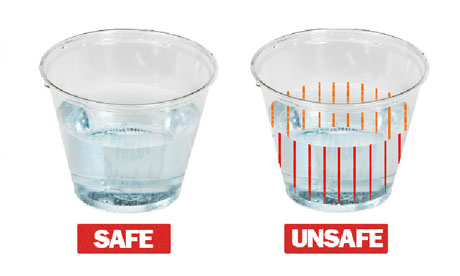
What if the cup you are drinking from – or straw you're drinking through – could warn you that someone had spiked your drink? That's just what new drinkware startup DrinkSavvy hopes it can achieve with a line of cups, glasses, straws and stirrers that change color or pattern in the presence of common "date-rape" drugs GHB, ketamine, or Rohypnol.
Last December, the company raised $52,000 through the crowdfunding site Indiegogo. Now they are gearing up for the first deliveries of their product to backers in September.
Most of the Indiegogo backers are individuals who want the product for personal use, says DrinkSavvy founder Mike Abramson, but the company has since been approached by bar and restaurant owners looking to "swap out" their drinkware on a larger scale, too.
"We're in the beta-testing phase now," Abramson said, adding that DrinkSavvy products won't be commercially available until mid-2014.
Abramson got the concept for his inconspicuous testers after his own experience being "roofied."
"I was out at a club in Boston a few years back celebrating a friend's birthday, and I went to the bar to get my first drink of the night. Not long thereafter, it started to feel much more like my 15th drink, so there was clearly something wrong," he recounted.
"My friends managed to get me back home safely, but waking up the next morning not knowing really anything that had happened the night before was a really terrifying experience."
Abramson found existing drink-testing kits – most often in the form of paper tabs – to be too cumbersome and socially awkward. With the help of John MacDonald, a professor of chemistry at the Worcester Polytechnic Institute, he came up with the concept for integrating an indicator directly into drinkware.
"The neat thing is that the cups and straws look just like any other cup or straw, so you don't really need to do anything," Abramson said. "All you have to do is drink with it and you'll be provided with continuous monitoring of your drink.
"The cup or straw you're using, which remains in constant contact with your drink, will immediately change color – within three seconds or so – from coming in contact with date-rape drugs."
Hard numbers on GHB, ketamine, or Rohypnol druggings and drug-facilitated sexual assaults are hard to come by, as many cases go unreported, but a 2007 estimate puts the number of US women who experience drug-related assault at around 200,000 per year.
While cases of sexual assault involving alcohol and voluntarily taken drugs like cocaine and marijuana are much more common than those involving date-rape drugs, Abramson said that doesn't mean the risks aren't real.
"Everybody already knows [or should know] that it's a very real possibility that you could get drugged. Certainly it happens enough now," he said.
"Whether it's drug-related or alcohol-related, the very best way to prevent any substance-related sexual assault is through education. If you can raise awareness about it, you're doing half the battle right there. While our products right now are focused on combating drug-facilitated sexual assault, the larger message is much more important."
DrinkSavvy products will also be made available for free for select US rape crisis centers after the commercial roll-out in 2014.

